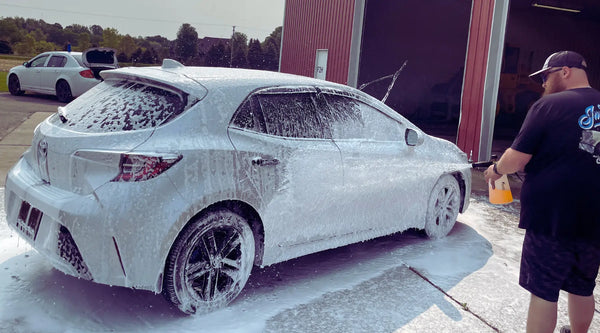How To Use Touchless Wash Soaps: 2-Step Fleet Washing
If you’re reading this article, you are likely already very familiar with equipment washing and looking for faster/more efficient ways to get the job done. In this article I’ll explain scenarios which benefit from touchless 2-step soaps, how the soaps work, and techniques to help maximize the effectiveness of touchless truck wash soaps.
Let's dive in.
The Growing Popularity of Touchless Truck Washing
Touchless soaps have been around for more than 50 years in the Transportation Industry and are now making their way into the retail world for everyday vehicle enthusiasts. Notably, car enthusiasts with ceramic coated vehicles have started using touchless truck wash soaps as a frictionless way to keep their car clean without the risk of scratches from a friction mitt wash. So, whether you’re a car enthusiast, an owner-operator, fleet washer, or own a fleet yourself, you can benefit from the use of touchless 2-step soaps as part of your wash regimen.

Touchless Wash 101
True to its name, touchless truck wash soaps do not require you to scrub between steps. The process is very straightforward:
- Spray the step 1 soap to cover your target area.
- Let the step 1 soap dwell for 30-60 seconds.
- Spray the step 2 soap directly overtop the step 1.
- Let both steps dwell on the surface for an additional 30-60 seconds.
- Rinse thoroughly with a pressure washer and 30-40° rinse tip. Make sure to overlap your rinses working from bottom to the top. (This may sound backwards to you, but we’ll explain later)
How Touchless Truck Wash Soaps Work
The science that makes touchless 2-step soaps work is really the magic here. Remember, dirt and grime stick to your vehicle because of static electricity. This means that in order to remove the grime, all we need to do is break that static electricity bond holding the dirt to the surface.
The Science:
The 2 different soaps used in touchless trucks washing consist of a step 1 which is acidic (low pH) and a step 2 which is alkaline (high pH). Static electricity makes both positive and negatively charged grime particles stick to the surface.
The low pH step 1 helps to break down the negatively charged road grime particles (this greasy layer of grime is often referred to as traffic film) and the high pH step 2 helps to loosen the dirt and other types of grime by neutralizing the positively charged particles. The step 2 also neutralizes the pH of the step 1, leaving you with a neutral pH solution that is safer for the environment upon rinse.
Once the negative and positive particles have been neutralized, you use your pressure washer lance to knock the dirt and grime off, leaving behind a clean surface. If you’ve ever washed large equipment with a mitt or brush, you understand how time consuming that process can be. So, having a quicker way to maintain your equipment’s cleanliness is a true game changer.

Does Touchless Truck Washing Replace Mitt/Brush Washes?
Yes and no. Mitt washing is still a favorite for those weekend wash warriors who enjoy taking the time to clean every nook and cranny with an eagle eye and gentle touch…. Amen! Hand washes like this are still the best way to ensure your vehicle is 100% clean. However, times have changed and soap technology has advanced substantially. Now, using touchless truck wash soap is a no-brainer for anyone looking to keep their vehicles clean when there isn’t enough time to do a full on exterior detail or it’s simply too cold outside to be messing with buckets.
Touchless soaps are commonly used to maintain a vehicle in between a good hand wash. If you stay on top of your wash protocol, touchless soaps are what you want to use for the in between washes. To put it plainly, you should still be hand washing your vehicle every couple of weeks, but you can use the touchless soaps in between to help keep the vehicle clean. In the winter months, these soaps will neutralize road salt and reduce the harsh effects that harmful ice melting road chemicals have on your vehicle. Using something like a foam-on rinse-off car wax after your washes is another way to help speed up your wash and maximize the effects of touchless truck washing.
As mentioned earlier, using touchless 2-step soaps to maintain the integrities and longevity of ceramic coatings. Using touchless soaps on ceramics surfaces keep the ceramic technologies working properly and keeps wash mitts and brushes off the protected surface. Less friction on your surface = less wear on the ceramic coating. So, in the case of ceramic coated vehicles, touchless wash soaps can absolutely replace mitt washing all together.
With all that being said, if you’re vehicle rarely ever gets washed and has a lot of buildup, touchless soaps probably won’t cut it. If this is the case for your ride, time to grab a brush. For those of you who stay on top of your washes, touchless will be a welcomed upgrade for your wash protocol.

Proper Techniques for Touchless 2-Step Washing
Spraying the chemicals on is as simple as mentioned above in the “Touchless 2-Step Wash 101” section, but there are some techniques you should be using to get the best end result. This is where we tackle the age-old debate on whether it’s best to rinse from top to bottom or bottom to top. It’s true that when rinsing traditional wash shampoos, you want to rinse from the top down, as to avoid having to re-rinse areas. Touchless 2-step soaps are the exception to this methodology.
For touchless truck wash soaps, start rinsing from the bottom and work your way up, keeping your wand level with the ground so that the water pressure is hitting your surface at a 90 degree angle. Essentially, hitting the grime head-on.
There are a couple reasons why we recommend rinsing from bottom up:
1. Since rinsing is the most important and tedious step for touchless soaps, this allows you to see where you have already rinsed. Bottom up rinsing makes it easier to overlap your rinse pattern, maximizing your clean and reducing the chance of missing a spot.
2. This method prevents soaps from being rinsed off prematurely like it would when rinsing top down. Rinsing bottom up ensures the soaps have the maximum amount of working time on your surface until you’re ready to rinse it off.
It’s important to remember that your rinse tip is acting as a replacement to a traditional brush or mitt. You’re not just rinsing off the soap, you’re using the pressure to finish knocking off the grime that has been neutralized by the soap. Just like your brush or mitt would be doing with friction.
If you’d like a visual explanation and demonstration of these techniques, take a look at this in-depth 2-step touchless wash tutorial. I encourage you watch them to see how you can improve your cleaning techniques. These are key points to achieving the best end result when using touchless wash soaps.
Different Touchless Formulas for Multiple Applications
Now that you know the basics, you probably want to know how to choose the best touchless truck wash soap for your situation. Not all touchless 2-step soaps are created equal.
For the majority of people out there, the safest option would be these touchless truck wash soaps. Touchless 1 & 2 are specially formulated to be safe on all exterior vehicle surfaces including ceramic coatings, paint, plastics, rubber, and polished metals.
If you’re someone looking for the strongest commercial grade truck wash chemicals on the market, you’d be better suited with our PRO line of touchless chemicals. We offer several different types of touchless truck wash soaps for different scenarios such as trucks with polished metals, aluminum brightening, or agricultural and construction equipment.
We're Here To Help
If you have any questions along the way, feel free to reach out to us at 616-777-7175 or at help@washproduct.com. We’re passionate about helping you keep your equipment clean and dedicated to your success.
Nov 09, 2023



